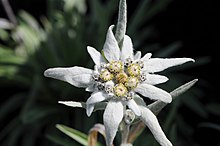Edelweiß
| Edelweiss | |
|---|---|
 |
|
| Close-up of flower. | |
| Scientific classification | |
| Kingdom: | Plantae |
| (unranked): | Angiosperms |
| (unranked): | Eudicots |
| (unranked): | Asterids |
| Order: | Asterales |
| Family: | Asteraceae |
| Tribe: | Gnaphalieae |
| Genus: | Leontopodium |
| Species: | L. nivale |
| Binomial name | |
|
Leontopodium nivale (Ten.) Huet ex Hand.-Mazz. |
|
Leontopodium nivale, commonly called edelweiss (English pronunciation /ˈeɪdəlvaɪs/), is a well-known mountain flower, belonging to the Asteraceae (daisy or sunflower family).
The plant prefers rocky limestone places at about 1,800–3,000 metres (5,900–9,800 ft) altitude. It is non-toxic, and has been used traditionally in folk medicine as a remedy against abdominal and respiratory diseases. The dense hair appears to be an adaptation to high altitudes, protecting the plant from cold, aridity, and ultraviolet radiation. As a scarce, short-lived flower found in remote mountain areas, the plant has been used as a symbol for alpinism, for rugged beauty and purity associated with the Alps and Carpathians, and as a national symbol, especially of Austria, Bulgaria, Romania, Slovenia, and Switzerland. According to folk tradition, giving this flower to a loved one is a promise of dedication.
The flower's common name derives from the German word "Edelweiß", which is a compound of "noble" and "white."
Edelweiß was one of several regional names for the plant and entered wide usage during the first half of the 19th century, in the context of early Alpine tourism. Alternative names include Chatzen-Talpen ("cat's paws"), and the older Wullbluomen ("wool flower," attested in the 16th century).
The scientific name is a latinisation of the Greek leontopódion, "lion's paw."
Since 1822, Leontopodium has no longer been considered part of the Gnaphalium genus, but classified alongside it as a distinct genus within the Gnaphalieae tribe. In 2003, Leontopodium alpinum was re-classified as a subspecies of Leontopodium nivale. Thus, the alpine edelweiss is currently recognized as being divided into two subspecies, Leontopodium nivale subsp. alpinum (Cass.) Greuter and Leontopodium nivale subsp. nivale.
...
Wikipedia

